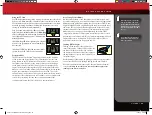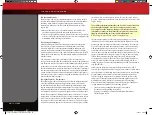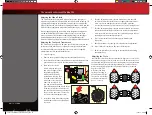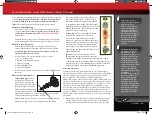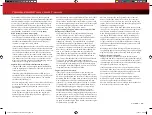
32 • T-MAXX
2.5
2
1.5
1
0.5
0
0
10
20
30
40
60
70
80
90
100
50
Wheel Force (lb)
Wheel Travel (mm)
Wheel Force vs. Wheel Travel
Lower Mount 1, Upper Mount 0
Lower Mount 2, Upper Mount 0
Lower Mount 1, Upper Mount A
Lower Mount 2, Upper Mount A
Lower Mount 3, Upper Mount A
Lower Mount 4, Upper Mount A
Lower Mount 1, Upper Mount B
Lower Mount 2, Upper Mount B
Lower Mount 3, Upper Mount B
Lower Mount 4, Upper Mount B
Less Firm
More Firm
Lower Mount 4
Lower Mount 3
Lower Mount 2
Lower Mount 1
TUNING ADJUSTMENTS
For easier access to the
rear-most shock mounting
screw, remove the one end
of the rear turnbuckle. In the
front, remove the suspension
pin from the lower front
suspension arm to gain easier
access to the lower shock
mounting screws.
Shock Mounting Positions
Big bumps and rough terrain require a softer
suspension with the maximum possible
suspension travel and ride height. Racing on
a prepared track or on-road use requires a
lower ride height and firmer, more progressive
suspension settings. The more progressive
suspension settings help reduce body roll
(increased roll stiffness), dive during braking, and
squat during acceleration.
The innermost upper shock mounting position
(0) on the shock tower is intended for use with
the first generation T-Maxx suspension arms.
With the second generation arms (2.5-powered T-Maxx), position (0) can be
used for tuning with the inner pair of lower shock mounting positions on the
arm (1,2). It is not compatible with lower shock mounting positions 3 and 4
on the second generation (2.5-powered T-Maxx) arms. Upper shock mounting
position (A) should generally be used with lower shock mounting positions
1 and 2. Generally, upper shock mounting position (B) should be used with
lower shock mounting positions 3 and 4. Other combinations may be used to
achieve individualized suspension settings.
Lower Shock Mounting Positions
In the out-of-the-box configuration, the shocks are installed in position (A) on
the shock tower and position (2) on the lower suspension arm. This setting
allows for moderate suspension travel and ride height. The more vertical
position of the shocks allows for lower shock progression and the soft, plush
feel that’s characteristic of the T-Maxx.
The outer pair of holes on the lower suspension arm should be used to lower
the ride height of the T-Maxx and increase the spring force (at the wheel).
This setting will improve high-speed cornering on smoother terrain by
lowering the center of gravity and providing a firmer suspension feel. Body
roll, brake dive, and squat will be reduced.
Spring rate
(at the wheel) increases as the lower shock mounting position
is moved from position (1) to position (4). This is equivalent to using stiffer
springs. Use higher spring rate settings for flatter terrain with smaller and
fewer bumps and lower spring rate settings for bigger bumps.
Ride height
decreases as the lower shock mounting position is moved from
position (1) to position (4). Each pair of lower shock mounting holes (1,2 and
3,4) has equal ride height. Use lower ride height for high-speed cornering
and flat terrain, and when racing on relatively smooth tracks. Increase the
ride height for rougher terrain and tracks.
Upper Shock Mounting Positions
The upper shock mounting positions will have the opposite affect on the
suspension that the lower shock mounting positions.
Spring rate
(at the wheel) increases as the upper shock
mounting position is moved from position (A) to position (B).
Ride height
is not affected by changes in the upper shock
mounting position.
Use the chart below to see the effect of the various shock mounting positions.
The horizontal length of the lines indicates the amount of suspension travel.
The angle or slope of the lines indicates the spring rate (at the wheel).
49104-1-KC2230-R00-T-Maxx-Operating.indd 32
10/30/14 5:10 PM






